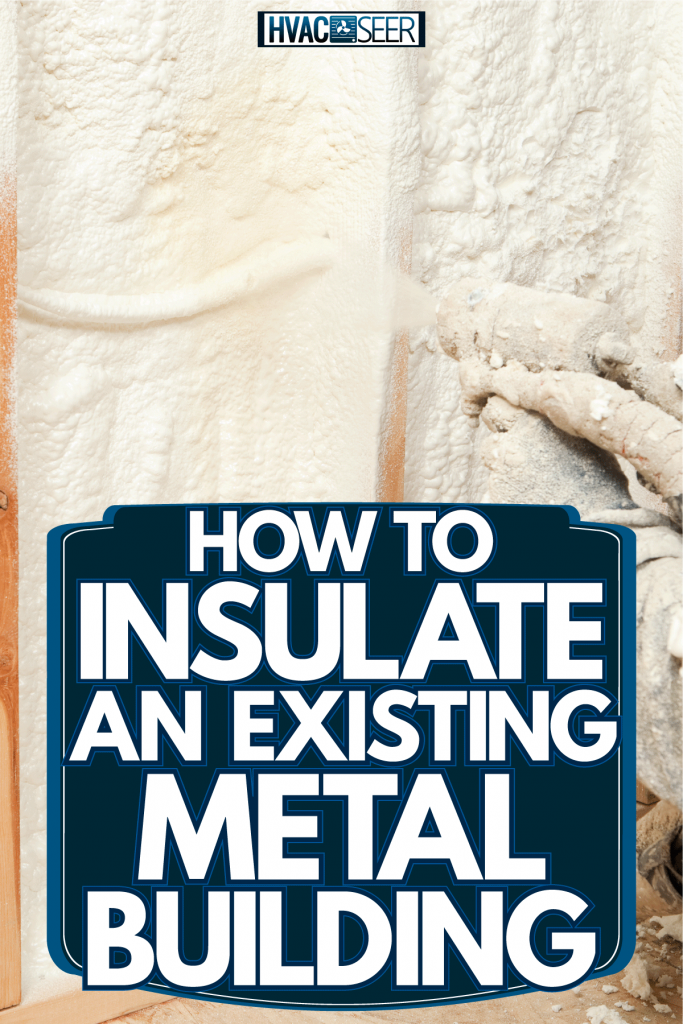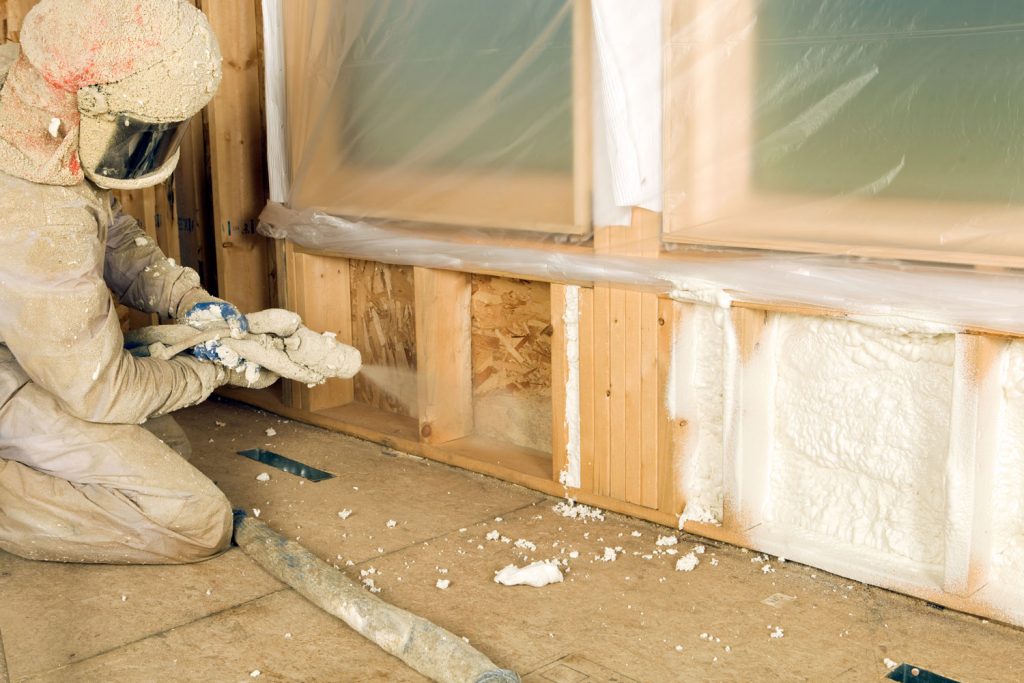The lack of insulation in most metal buildings leads to comfort and stored item integrity issues. Therefore, you might wonder how to insulate an existing metal building. This post combines up-to-date research and industry professional knowledge to answer your question.
There are three ways to insulate a metal building. However, closed-cell spray foam is considered the best choice for metal buildings. All the techniques are:
- Closed-Cell Spray Foam Insulation
- Closed-Cell Rigid Foam Insulation
- Fiberglass Batt Insulation
Keep reading the rest of this post for details on each of the above techniques. We include the pros and cons and directions for each insulation type but focus on closed-cell spray foam. To conclude, we answer several questions related to the topic of this post and provide an additional reading list.

How To Insulate An Existing Metal Building
Of the three insulation types discussed here, spray foam insulation comes with the fewest drawbacks for installation in metal construction and even strengthens the building. However, it also is the most technical to install and can be the most expensive.

Following spray foam, foam board types that double as vapor barriers are recommended next. These closed-cell insulations are simpler to install but do require additional labor.
Finally, fiberglass batts can be used on existing metal buildings. However, fiberglass batts do not include any vapor barrier and let moisture and air move through their mass easily. This means that you will need to add a separate vapor barrier with your batt insulation to avoid serious issues.
Closed-Cell Spray Foam Insulation
While it is possible to hand spray closed-cell spray foam, this is not an efficient way to insulate an entire metal building. Instead, this product is most commonly applied using spray trucks, specialty hoses, and spray gun applicators.
Given this, consider hiring a professional company to spray foam your metal building. This way, you are sure that the job will be done correctly. However, it is possible to spray foam a metal building as a DIY project.
How to Closed-Cell Spray Foam A Metal Building Yourself
To spray foam a metal building yourself, follow these directions. First, tape and plastic, then don the proper PPE, then set up the sprayer, now foam the entire building, and, finally, clean up the space.
1. Tape and Plastic
First, tape off all items and locations that you want to stay foam-free. This means windows, floors, outlets, switches, tools, and anything else stored in your metal building. Spray foam is tough to clean from any surface once it dries.
Click here for painter's tape from Amazon.
Use masking tape and painter's plastic. The more time you spend on this step, the easier the clean-up will be at the end of the project. The easiest choice is to wait for fair weather and remove everything from the building before starting the taping process.
Click here for painter's plastic from Amazon.
Spread the plastic over all large areas, like floors and windows, and use the tape to attach the plastic at the edges. Also, tape over all of the outlets and other small items.
2. Put on PPE
Click here for a full-face respirator from Amazon.
Now, put on the proper personal protective equipment. This means eyewear, a full body suit, gloves, and a respirator. This step is crucial because of the off-gassing from the spray foam as it cures.
3. Set up Foam
Click here for a DIY spray foam kit from Amazon.
Set up the rental foam pump or the disposable foam spray setup. This may take a little trial and error, but there should be relatively clear directions on the product's package or in the included literature.
4. Spray Foam
Now, spray your foam. The foam expands significantly after first contacting the wall. Therefore, be sure not to overspray when you first begin. To accomplish this, spray just a little bit and wait to see how much it expands.
First, spray the edges of your stud bays. This ensures that the joint elements are fully sealed. Then, spray evenly through the middle of the stud bay. Whenever you are spraying, you will want to use long even strokes.

When you spray around existing electrical wiring and switches, outlets, junction boxes, plumbing, or other materials, you will need to take special care. Foam gets behind these elements, expands, and pushes the material out of place.
To avoid this, you will need to use your fingers or a tool to hold the element in place as the foam expands. This does not take significant force or time since the foam fully expands in a matter of seconds.

As you spray, you will get a better and better feel for how the foam applies. This means that starting in a simple out-of-the-way area devoid of electrical and other barriers is a wise move.
If, at first spray, you do not get the thickness of insulation you desire, you can easily spray over what you already have applied. Once you have the hang of it, spray the entire building with the goal of an even continuous layer of insulation on all the walls and ceiling.
5. Clean up
Once you are done spraying, it takes about 24-hours for the product to cure fully. However, the product fully expands and is relatively hard quite quickly, so there is no reason to hold off on the clean-up.
Click here for acetone from Amazon.
Therefore, feel free to clean up the plastic, tape, and dropped foam soon after spraying. Use a scraper or acetone for any stray foam.
Closed-Cell Rigid Foam Insulation
To install closed-cell rigid foam insulation, you will want to cut and glue the insulation in place. Then, caulk all gaps to complete the vapor barrier quality of the insulation.
1. Cut and Glue Insulation
Closed-cell foam board comes in rigid sheets similar to plywood. Using silicone caulk, install these sheets directly to your metal walls.
Click here for a closed-cell foam board from Amazon.
Inevitably, the sheets will need to be cut to fill stud bays and to notch around outlets and windows. Use a tape measure, straight edges, and a utility knife to cut the foam board so that you get solid coverage over the entire area. The goal is for all gaps to be 1/4-inch or less.
2. Caulk Seams
Click here for silicone caulk from Amazon.
Now, use silicone caulk or canned spray foam to fill all seams. This means places where two foam boards meet and junctions with framing and building elements.
Fiberglass Batt Insulation
Finally, it is possible to install fiberglass batt insulation in your metal building.
1. Install Fiberglass
Unfortunately, fiberglass batts are usually not produced in large enough batts to neatly fit in the stud bays of metal construction. Therefore, you will need to use a twine or wood lathe to hold the fiberglass in place.
Click here for twine from Amazon.
Overall, the goal is to fill the stud bays to the full thickness of the framing elements. This maximizes R-value while leaving a location to affix your vapor barrier. Unfortunately, many metal buildings have very thin studs, so they do not provide much room for high R-value fiberglass.
2. Install Vapor Barrier
Click here for poly sheeting from Amazon.
Now, install a Tyvek or poly sheeting vapor barrier to the studs. Be meticulous with this step because even small gaps will allow moisture to collect within the insulation assembly. It may be good to tape all seams to provide an even better barrier.
Do you need a vapor barrier in a metal building?
The answer to this question is an emphatic yes. Unlike many other types of building material, metal is impervious to the movement of water and water vapor. Therefore, any moisture that gets through your insulation to the metal has no way to escape.
Without a vapor barrier, this moisture will build up over time until bacteria and mold start to eat away at the wooden parts of your building. The moisture will lead to corrosion, rust, and other structural issues even with all-metal construction.

Vapor barriers are significant once the metal building is insulated. Namely, warm air can hold more moisture than cold air. If the warm interior air permeates your insulation, it will eventually come into contact with the cold metal walls.
When this happens, the air will cool, and some of the moisture will fall out, condensing on the metal. And, according to the Department of Energy, this moisture will not be able to escape because metal is considered a class I or virtually impermeable vapor barrier.
How do you stop condensation in a metal building?
To stop condensation, install a vapor barrier. Then, if you are still experiencing condensation, consider installing an exhaust fan to expel the excess moisture.
Can you put regular insulation in a metal building?
It is possible to install fiberglass batts in a metal building as described above. However, the installation process is not simple, and the final product is prone to condensation and other moisture issues.
How do you attach insulation to metal?
Attach insulation to metal using either silicone caulk or canned spray foam. The advantage of silicone caulk is that it will not expand as much and push your insulation away from the wall.
Additional Reading
To learn more about insulation as a remodel and spray foam, read these great HVAC Seer articles:
- How Deep Should Attic Insulation Be?
- How Long Does Spray Foam Insulation Smell?
- Spray Foam Temperature Settings [Cold And Hot Climate Issues]
In Closing

In this post, we provide directions for insulating an existing metal building. We provide three different options to accomplish this task with a recommendation for the best technique. To conclude, we answer a few related questions. Good luck!









